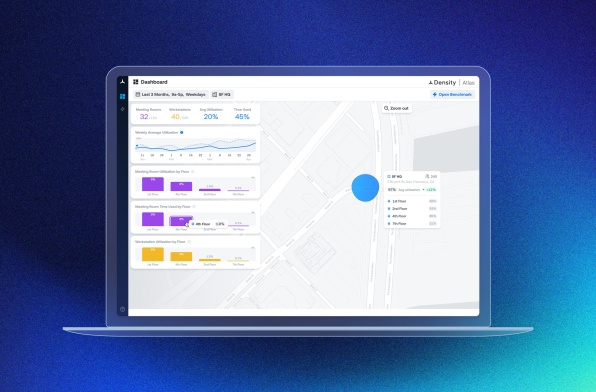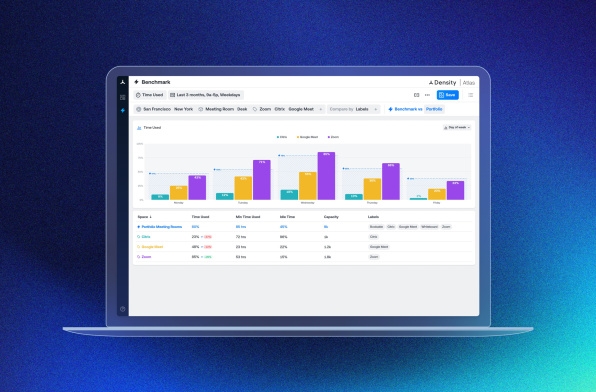Fortune 500 companies are are wasting millions on unused office space
The once forlorn office is coming back to life. Companies from Uber to LinkedIn to Apple are asking— or requiring—that workers come back at least a few days a week to do their work in actual physical offices. After two and a half years of pandemic caution and confusion, offices are once again humming.
Or at least parts of them are. A new study looking at thousands of workplaces of Fortune 500 companies in 13 cities finds that a significant amount of the space in those offices is sitting unused and empty for much of every workday.

The data come from workplace usage measurement company Density, which uses lidar and radar sensors in the offices of many of the biggest companies in the world to track how space is being utilized. To get a sense for how the return to work was going, Density looked at anonymized data from 2,000 different spaces within offices over the past two months to see how spaces were being put to use, or not. The analysis covered roughly 502,000 cumulative working hours in spaces ranging from private offices to open-floor–plan rooms to conference rooms of various sizes. Density CEO Andrew Farah says that during the 8 a.m. to 6 p.m. range, a surprising amount of these spaces within offices are left untouched.
“For 181,000 of those half–million hours, spaces are empty,” Farah says. “They’re spaces that are essentially paid for but nobody is using.” That means that these spaces are sitting empty for more than a third of working hours.
Extrapolating that out for the 2,000 office spaces in the dataset, Farah says this all adds up to more than $25 million a year that’s being spent on office real estate, which is sitting empty. Depending on the size of the space and its location, this can mean some very expensive offices and conference rooms are basically going to waste.
“We found a room worth $110,000 a year that was empty half the time. We found a room that is worth $87,000 per year that’s empty 83% of the time,” Farah says.

Though the data in the analysis are anonymized, Density’s sensors and software are used by companies including Etsy, Cisco Meraki, Okta, and Pinterest. “These are very large organizations. We’re talking about hundreds of thousands of employees,” Farah says. Density’s latest software package, Atlas, allows companies to run their own analyses to break down how much each section of an office is used, and even see how much square footage is available to its employees on a daily basis. The data show how much space is being utilized, and where cuts and savings may be possible.
Farah points to one example of a six-story office building in the dataset that was being far underutilized. “Based on use, it can support 4.7 times the number of people [currently] in the space,” he says. “All they have to do is take three floors, turn them off, consolidate everybody else on the other three floors, and they will save $868,000 a year on energy and cleaning costs.”

These kinds of insights can help companies plan and invest in their office real estate, which tends to be a company’s second biggest expenditure behind payroll. Farah says that the six-story office may not be able to immediately cut out three floors from its lease, but it can take this usage data into account the next time its lease goes up for renewal.
In the near term, companies can identify the specific areas in their offices that are getting the most—and least—traffic. Farah says the study shows strong usage numbers in smaller meeting rooms and abysmal figures for big, open rooms with assigned seating. These findings can enable companies to adjust their space planning and office designs on the fly. “Just (October 22, 2022) I saw a customer unassign all of their desks as a result of the data they were seeing,” Farah says. “Real estate is much more dynamic than, ‘Let’s just cut costs or let’s build a lot of stuff.’”
Farah notes that the data in the analysis has been normalized to remove any extreme outliers, and to account for what may be a slower return to the office scenario than some companies have planned. And though he says the data suggest that some companies’ return to work plans are more successful than others, the findings are less about how these spaces repopulate than how companies plan their offices for the way workers actually use them.
“I don’t know that I have a strong opinion about whether or not office use has to happen in order for a company to be successful,” he says. “I just think that not knowing and having a really large asset on your balance sheet that costs $73 to $86 to $125 per square foot, depending on the region, seems like an untenable thing long term.”
(9)


